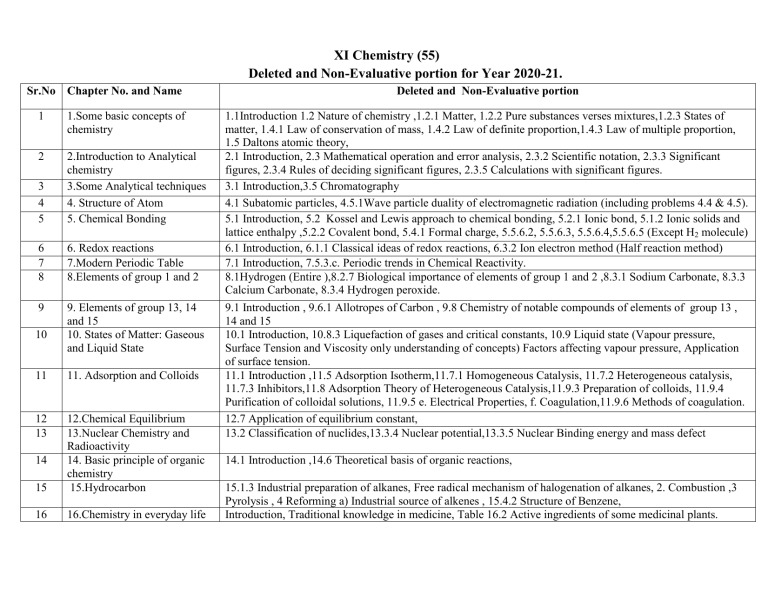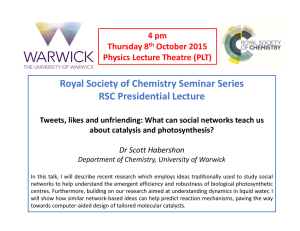
XI Chemistry (55) Deleted and Non-Evaluative portion for Year 2020-21. Sr.No Chapter No. and Name 1 1.Some basic concepts of chemistry 2 3 4 5 2.Introduction to Analytical chemistry 3.Some Analytical techniques 4. Structure of Atom 5. Chemical Bonding 6 7 8 6. Redox reactions 7.Modern Periodic Table 8.Elements of group 1 and 2 9 9. Elements of group 13, 14 and 15 10. States of Matter: Gaseous and Liquid State 10 11 11. Adsorption and Colloids 12 13 15 12.Chemical Equilibrium 13.Nuclear Chemistry and Radioactivity 14. Basic principle of organic chemistry 15.Hydrocarbon 16 16.Chemistry in everyday life 14 Deleted and Non-Evaluative portion 1.1Introduction 1.2 Nature of chemistry ,1.2.1 Matter, 1.2.2 Pure substances verses mixtures,1.2.3 States of matter, 1.4.1 Law of conservation of mass, 1.4.2 Law of definite proportion,1.4.3 Law of multiple proportion, 1.5 Daltons atomic theory, 2.1 Introduction, 2.3 Mathematical operation and error analysis, 2.3.2 Scientific notation, 2.3.3 Significant figures, 2.3.4 Rules of deciding significant figures, 2.3.5 Calculations with significant figures. 3.1 Introduction,3.5 Chromatography 4.1 Subatomic particles, 4.5.1Wave particle duality of electromagnetic radiation (including problems 4.4 & 4.5). 5.1 Introduction, 5.2 Kossel and Lewis approach to chemical bonding, 5.2.1 Ionic bond, 5.1.2 Ionic solids and lattice enthalpy ,5.2.2 Covalent bond, 5.4.1 Formal charge, 5.5.6.2, 5.5.6.3, 5.5.6.4,5.5.6.5 (Except H2 molecule) 6.1 Introduction, 6.1.1 Classical ideas of redox reactions, 6.3.2 Ion electron method (Half reaction method) 7.1 Introduction, 7.5.3.c. Periodic trends in Chemical Reactivity. 8.1Hydrogen (Entire ),8.2.7 Biological importance of elements of group 1 and 2 ,8.3.1 Sodium Carbonate, 8.3.3 Calcium Carbonate, 8.3.4 Hydrogen peroxide. 9.1 Introduction , 9.6.1 Allotropes of Carbon , 9.8 Chemistry of notable compounds of elements of group 13 , 14 and 15 10.1 Introduction, 10.8.3 Liquefaction of gases and critical constants, 10.9 Liquid state (Vapour pressure, Surface Tension and Viscosity only understanding of concepts) Factors affecting vapour pressure, Application of surface tension. 11.1 Introduction ,11.5 Adsorption Isotherm,11.7.1 Homogeneous Catalysis, 11.7.2 Heterogeneous catalysis, 11.7.3 Inhibitors,11.8 Adsorption Theory of Heterogeneous Catalysis,11.9.3 Preparation of colloids, 11.9.4 Purification of colloidal solutions, 11.9.5 e. Electrical Properties, f. Coagulation,11.9.6 Methods of coagulation. 12.7 Application of equilibrium constant, 13.2 Classification of nuclides,13.3.4 Nuclear potential,13.3.5 Nuclear Binding energy and mass defect 14.1 Introduction ,14.6 Theoretical basis of organic reactions, 15.1.3 Industrial preparation of alkanes, Free radical mechanism of halogenation of alkanes, 2. Combustion ,3 Pyrolysis , 4 Reforming a) Industrial source of alkenes , 15.4.2 Structure of Benzene, Introduction, Traditional knowledge in medicine, Table 16.2 Active ingredients of some medicinal plants. Note for XI Practical: Due to Covid-19, 60% of total Chemistry practicals should be conducted by teachers during academic year 2020-21. XII Chemistry (55) Deleted and Non- Evaluative portion for Year 2020-21. Sr.No. Chapter No. and Name 1. 1.Solid State 2 2.Solutions 3 3.Ionic Equlibria 4 4.Chemical Thermodynamics 5 5.Electrochemistry 6 6.Chemical Kinetics 7 7.Elements of Groups 16,17 and 18 8 8.Transition and inner transition elements 9. 9.Co-ordination Compounds 10 11 10.Halogen Derivatives 11.Alcohols , Phenols and Ethers Deleted and Non evaluative portion 1.2.1 Crystalline solid, 1.2.2.Amorphorus solid, 1.7.3 Packing efficiency of metal crystal in fcc lattice, Table 1.3 Edge length and particle parameters in cubic system, Table 1.4 Point no.3 fcc/hcp only, 1.9 Electrical properties of solids, 1.10 Magnetic properties of solid Demonstration and Exceptions to Henry’s Law, 2.11.1 Van’t Hoff factor (i), 2.11.2 Modification of expressions of colligative property, 2.11.3 Van’t Hoff factor and degree of dissociation, Problem 2.10,2.11,2.12,2.14 3.1 Introduction, 3.6.2 Acidity, basicity and neutrality of aqueous solution, 3.8.3 Properties of Buffer 3.10.1 Common ion effect and solubility 4.1 Introduction, 4.2.6 Thermodynamic Equilibrium, key points for spontaneous process, 4.11.3 Entropy and spontaneity, 4.11.4 Second law of thermodynamics, 4.11.5 Gibbs energy,4.11.6 Gibbs energy and spontaneity, 4.11.7 Spontaneity and ΔH or ΔS, 4.11.8 Temperature of equilibrium, 4.11.9 Gibbs function and equilibrium constant, Problem 4.16,4.17,4.18, Problem 4.19 and 4.20 5.1 Introduction, 5.2.2 Ionic conduction,5.2.3 Measurement of conductivity of solution, Significance of molar conductivity, 5.4.1 Electrochemical reactions ,5.4.2 Electrodes, 5.10.1 Dry cell, 5.10.2 Lead accumulator, 5.11 Fuel cells 6.1 Introduction, 6.6 collision theory of bimolecular reactions, 6.7 Temperature dependence of reaction rate, Problem 6.12 and 6.13, Problem 6.14 Introduction, Table 7.2 Atomic and physical properties of group 16 elements, Table 7.3,7.4 Atomic and physical properties of group 17 and 18 elements, Table 7.5,7.6 Properties of hydrides of Group 16 and 17 elements, 7.9 Oxygen and compounds of oxygen, Fig.7.1 Flow diagram for manufacture of sulphuric acid, 7.11.2 Hydrogen chloride, 7.13 Compounds of Xenon (Excluding Table no.7.14) 8.1.1 General Introduction , Table 8.5 Atomic Properties of First Transition series, Table 8.6 Ionisation enthalpy of first transition series Remember, 8.3 Compounds of Mn and Cr, 8.6.1 Metallurgy 8.6.2 Extraction of iron form hematite ore using blast furnace, Table 8.12 I.E of Lanthanoids, Problem, Table 8.13 Effective Magnetic moments of Lanthanoids 9.9.6 CFT, 9.9.7 Factors affecting Crystal Field splitting parameters, 9.9.8 Colour of the octahedral complexes, 9.9.9 Tetrahedral complexes 10.3.5 Sandmeyer’s reaction, 10.5.5 Representation of configuration of molecule, 10.6.1 Laboratory test of haloalkane, 10.7 Uses and Environmental effect of some polyhalogen compound Preparation of alcohols a) From alkyl halide b) By acid catalyzed hydration of alkenes, a)Laboratory test of alcohols and phenol i) Litmus test , ii) Reaction with base


